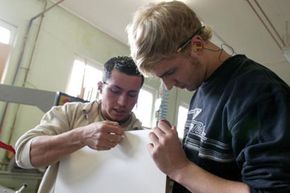In these difficult economic times, many high school and college-age students might be thinking about the practicality of spending $40,000 dollars a year for a liberal arts education when a job placement after graduation is uncertain, to say the least. If you like working with your hands or spending time outdoors, trade school might be a good option for you. In a trade school, you hone your skills to pursue careers ranging from anything from hairdressing to plumbing, from carpentry to massage therapy.
While trade schools are often less expensive than four-year universities and usually offer shorter programs, they still cost money. To attend trade school, you have to pay tuition, just as you would to attend college.
Advertisement
What are your options if you want to attend trade school but require financial aid to do so? You can apply for loans, receive grants or even win scholarships for trade school. But before you get the financial aid for trade school, you first need to consider several things that might affect how much aid you receive and in what form you'll receive it.
First, you should pick a career that most interests you. Many scholarships to trade school are offered for specific trades. For example, some scholarships might only be available to plumbers, while others are for welders.
Once you've decided on a trade, you should learn more about it or acquire some experience in the field. You might seek a mentor who has knowledge of the industry to give you useful information about the field or tell you about the best programs for your field. Sometimes, trade school scholarships only are offered for a specific school, so deciding on a particular program and learning all you can about that school might increase your chances of earning financial aid. Trade schools will be more likely to offer you a scholarship if you demonstrate interest and knowledge of your field.
On the next page, we'll take a look at the step-by-step process of applying for trade school financial aid.
Advertisement


